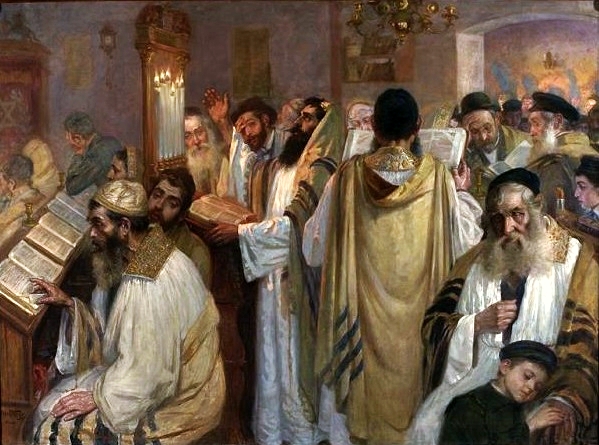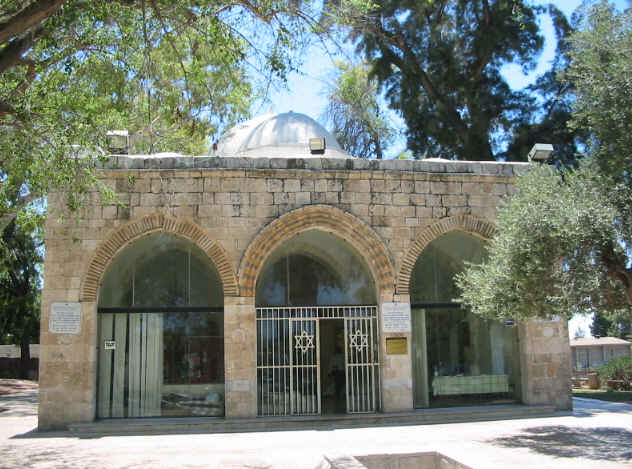|
R. H.
Rosh Hashanah ( he, רֹאשׁ הַשָּׁנָה) is the name of a text of Jewish law originating in the Mishnah which formed the basis of tractates in both the Babylonian Talmud and the Jerusalem Talmud of the same name. It is the eighth tractate of the order '' Moed''. The text contains the most important rules concerning the calendar year, together with a description of the inauguration of the months, laws on the form and use of the shofar and laws related to the religious services during the Jewish holiday of Rosh Hashanah. Mishna The Mishnah commences with an account of the four beginnings of the religious and the civil year ( 1:1); it speaks of the four judgement-days of the pilgrim festivals and Rosh ha-Shanah ( 1:2); of the six months in which the messengers of the Sanhedrin announce the month ( 1:3); of the two months, the beginnings of which witnesses announce to the Sanhedrin even on the Sabbath ( 1:4), and even if the moon is visible to every one ( 1:5); Gamliel eve ... [...More Info...] [...Related Items...] OR: [Wikipedia] [Google] [Baidu] |
Shofar
A shofar ( ; from he, שׁוֹפָר, ) is an ancient musical horn typically made of a ram's horn, used for Jewish religious purposes. Like the modern bugle, the shofar lacks pitch-altering devices, with all pitch control done by varying the player's embouchure. The shofar is blown in synagogue services on Rosh Hashanah and at the end of Yom Kippur; it is also blown every weekday morning in the month of Elul running up to Rosh Hashanah. Shofars come in a variety of sizes and shapes, depending on the choice of animal and level of finish. Bible and rabbinic literature The shofar is mentioned frequently in the Hebrew Bible, the Talmud and rabbinic literature. In the first instance, in , the blast of a shofar emanating from the thick cloud on Mount Sinai makes the Israelites tremble in awe. The shofar was used to announce the new moon and the Jubilee year. The first day of Tishrei (now known as Rosh Hashana) is termed a "memorial of blowing", or "day of blowing", the shofar. ... [...More Info...] [...Related Items...] OR: [Wikipedia] [Google] [Baidu] |
Shabbat
Shabbat (, , or ; he, שַׁבָּת, Šabbāṯ, , ) or the Sabbath (), also called Shabbos (, ) by Ashkenazim, is Judaism's day of rest on the seventh day of the week—i.e., Saturday. On this day, religious Jews remember the biblical stories describing the creation of the heaven and earth in six days and the redemption from slavery and The Exodus from Egypt, and look forward to a future Messianic Age. Since the Jewish religious calendar counts days from sunset to sunset, Shabbat begins in the evening of what on the civil calendar is Friday. Shabbat observance entails refraining from work activities, often with great rigor, and engaging in restful activities to honour the day. Judaism's traditional position is that the unbroken seventh-day Shabbat originated among the Jewish people, as their first and most sacred institution. Variations upon Shabbat are widespread in Judaism and, with adaptations, throughout the Abrahamic and many other religions. According to ''halakha ... [...More Info...] [...Related Items...] OR: [Wikipedia] [Google] [Baidu] |
Yom Kippur
Yom Kippur (; he, יוֹם כִּפּוּר, , , ) is the holiest day in Judaism and Samaritanism. It occurs annually on the 10th of Tishrei, the first month of the Hebrew calendar. Primarily centered on atonement and repentance, the day's observances consist of full fasting and ascetic behavior accompanied by intensive prayer as well as sin confessions (traditionally inside of a synagogue). Alongside the related holiday of Rosh HaShanah, Yom Kippur is one of the two components of the "High Holy Days" of Judaism. Etymology () means "day" in Hebrew and () is translated to "atonement". The common English translation of Yom Kippur is Day of Atonement; however, this translation lacks precision. The name Yom Kippur is based on the Torah verse, "...but on the 10th day of the seventh month it is the day of ''kippurim'' unto you..." The literal translation of ''kippurim'' is cleansing. Yom Kippur is a Jewish day to atone for misdeeds and become cleansed and purified from the ... [...More Info...] [...Related Items...] OR: [Wikipedia] [Google] [Baidu] |
Yavne
Yavne ( he, יַבְנֶה) or Yavneh is a city in the Central District of Israel. In many English translations of the Bible, it is known as Jabneh . During Greco-Roman times, it was known as Jamnia ( grc, Ἰαμνία ''Iamníā''; la, Iamnia); to the Crusaders as Ibelin; and before 1948, as Yibna ( ar, يبنى). History Yavne was one of the major ancient cities in the southern coastal plain, situated south of Jaffa, north of Ashdod, and east of the Mediterranean.Moshe Fischer, Itamar Taxel and David AmitRural Settlement in the Vicinity of Yavneh in the Byzantine Period: A Religio-Archaeological Perspective Bulletin of the American Schools of Oriental Research, No. 350 (May, 2008), pp. 7-35. Excavations were carried out on the ancient tell (mound created by accumulation of archaeological remains) known as ''Tel Yavne'' (Hebrew), which developed on a natural kurkar_hill._The_tell_was_inhabited,_possibly_continuously,_from_either_the_Bronze_or_Iron_Age_until_the_Mandato ... [...More Info...] [...Related Items...] OR: [Wikipedia] [Google] [Baidu] |
Nasi (Hebrew Title)
( ''nāśīʾ'') is a Hebrew title meaning "prince" in Biblical Hebrew, "Prince f the Sanhedrin">Sanhedrin.html" ;"title="f the Sanhedrin">f the Sanhedrin in Mishnaic Hebrew, or "President (government title), president" in Hebrew language#Modern Hebrew, Modern Hebrew. Usage Genesis and ancient Israel The noun ''nasi'' (including its grammatical variations), occurs 132 times in the Masoretic Text of the Hebrew Bible, and in English is usually translated "prince," occasionally "captain." The first use is for the twelve "princes" who will descend from Ishmael, in the Book of Genesis , and the second use, in , is the Hethites recognising Abraham as "a godly prince" (' ). In the Book of Leviticus (), in the rites of sacrifices for leaders who err, there is the special offering made by a "nasi". In the Book of Numbers (), the leader of each tribe is referred to as a ''nasi'', and each one brings a gift to the Tabernacle. In , occurring 38 years later in the Biblical story, the ' ... [...More Info...] [...Related Items...] OR: [Wikipedia] [Google] [Baidu] |
Tishri
Tishrei () or Tishri (; he, ''tīšrē'' or ''tīšrī''; from Akkadian ''tašrītu'' "beginning", from ''šurrû'' "to begin") is the first month of the civil year (which starts on 1 Tishrei) and the seventh month of the ecclesiastical year (which starts on 1 Nisan) in the Hebrew calendar. The name of the month is Babylonian. It is a month of 30 days. Tishrei usually occurs in September–October on the Gregorian calendar. In the Hebrew Bible, before the Babylonian Exile, the month is called Ethanim ( he, אֵתָנִים – ). In the Babylonian calendar the month is known as Araḫ Tišritum, "Month of Beginning" (of the second half-year). Edwin R. Thiele has concluded, in ''The Mysterious Numbers of the Hebrew Kings'', that the ancient Kingdom of Judah counted years using the civil year starting in Tishrei, while the Kingdom of Israel counted years using the ecclesiastical new year starting in Nisan. Tishrei is the month used for the counting of the epoch year – i.e., ... [...More Info...] [...Related Items...] OR: [Wikipedia] [Google] [Baidu] |
Joshua Ben Hananiah
Joshua ben Hananiah ( ''Yəhōšuaʿ ben Ḥánanyāh''; d. 131 CE), also known as Rabbi Yehoshua, was a leading tanna of the first half-century following the destruction of the Second Temple. He is the seventh-most-frequently mentioned sage in the Mishnah. Biography He was of Levitical descent, and served in the sanctuary as a member of the class of singers. His mother intended him for a life of study, and, as an older contemporary, Dosa ben Harkinas, relates, she carried the child in his cradle into the synagogue, so that his ears might become accustomed to the sounds of the words of the Torah. It was probably with reference to his pious mother that Yohanan ben Zakkai thus expressed himself concerning Joshua ben Hananiah: "Hail to thee who gave him birth".Pirkei Avot 2:8 According to another tradition Yohanan ben Zakkai praised him in the words of Ecclesiastes (4:12), "And a threefold cord is not quickly broken." Perhaps he meant that in Joshua the three branches of tradition ... [...More Info...] [...Related Items...] OR: [Wikipedia] [Google] [Baidu] |
Gamliel II
Rabban Gamaliel II (also spelled Gamliel; he, רבן גמליאל דיבנה; before -) was a rabbi from the second generation of tannaim. He was the first person to lead the Sanhedrin as ''nasi'' after the fall of the Second Temple in 70 CE. He was the son of Shimon ben Gamaliel, one of Jerusalem's foremost men in the war against the Romans, and grandson of Gamaliel I. To distinguish him from the latter he is also called Gamliel of Yavne. Biography He seemed to have settled initially in Kefar 'Othnai in Lower Galilee, but with the outbreak of the war with Rome, he fled to Jerusalem. From there, he moved to Yavne. In Yavne, during the siege of Jerusalem, the scribes of the school of Hillel had taken refuge by permission of Vespasian, and a new centre of Judaism arose under the leadership of the aged Johanan ben Zakkai, a school whose members inherited the authority of the Sanhedrin of Jerusalem. He was appointed ''nasi'' in approximately the year 80 CE. Leadership Gamal ... [...More Info...] [...Related Items...] OR: [Wikipedia] [Google] [Baidu] |
Av Bet Din
The ''av beit din'' ( ''ʾabh bêth dîn'', "chief of the court" or "chief justice"), also spelled ''av beis din'' or ''abh beth din'' and abbreviated ABD (), was the second-highest-ranking member of the Sanhedrin during the Second Temple period, and served as an assistant to the Nasi (Prince). The Av Beit Din was known as the "Master of the Court;" he was considered the most learned and important of these seventy members. Menahem the Essene served as Av Beth Din in the 1st century BCE, before abdicating to "serve the King" in 20 BCE. The House of Shammai attained complete ascendency over the Sanhedrin from 9CE until Gamaliel became Nasi in 30CE. Apparently the post of Av Beit Din was eventually filled, since the Babylonian Talmud states that Joshua ben Hananiah was Av Beit Din and Nathan the Babylonian was Av Beit Din. The Jerusalem Talmud tells the story of how Gamaliel II was deposed and Eleazar ben Azariah replaced him as Nasi. After Gamaliel was reinstated, Eleazar ben Azariah ... [...More Info...] [...Related Items...] OR: [Wikipedia] [Google] [Baidu] |
Bet Ya'azeḳ
Black Entertainment Television (acronym BET) is an American basic cable channel targeting African-American audiences. It is owned by the CBS Entertainment Group unit of Paramount Global via BET Networks and has offices in New York City, Los Angeles, Chicago, and was formerly headquartered in Washington, D.C. As of February 2015, approximately 88,255,000 American households (75.8% of households with television) receive the channel. History After stepping down as a lobbyist for the cable industry, Freeport, Illinois native Robert L. Johnson decided to launch his own cable television network. Johnson would soon acquire a loan for $15,000 and a $500,000 investment from media executive John Malone to start the network. The network, which was named Black Entertainment Television (BET), launched on January 25, 1980. Cheryl D. Miller designed the logo that would represent the network, which featured a star to symbolize "Black Star Power". Initially, broadcasting for two hours a ... [...More Info...] [...Related Items...] OR: [Wikipedia] [Google] [Baidu] |
Babylon
''Bābili(m)'' * sux, 𒆍𒀭𒊏𒆠 * arc, 𐡁𐡁𐡋 ''Bāḇel'' * syc, ܒܒܠ ''Bāḇel'' * grc-gre, Βαβυλών ''Babylṓn'' * he, בָּבֶל ''Bāvel'' * peo, 𐎲𐎠𐎲𐎡𐎽𐎢 ''Bābiru'' * elx, 𒀸𒁀𒉿𒇷 ''Babili'' *Kassite: ''Karanduniash'', ''Karduniash'' , image = Street in Babylon.jpg , image_size=250px , alt = A partial view of the ruins of Babylon , caption = A partial view of the ruins of Babylon , map_type = Near East#West Asia#Iraq , relief = yes , map_alt = Babylon lies in the center of Iraq , coordinates = , location = Hillah, Babil Governorate, Iraq , region = Mesopotamia , type = Settlement , part_of = Babylonia , length = , width = , area = , height = , builder = , material = , built = , abandoned = , epochs = , cultures = Sumerian, Akkadian, Amorite, Kassite, Assyrian, Chaldean, Achaemenid, Hellenistic, Parthian, Sasanian, Muslim , dependency_of = , occupants = , event = , excavations = , archaeologists = Hormuzd Rassam, Robe ... [...More Info...] [...Related Items...] OR: [Wikipedia] [Google] [Baidu] |
Bonfire
A bonfire is a large and controlled outdoor fire, used either for informal disposal of burnable waste material or as part of a celebration. Etymology The earliest recorded uses of the word date back to the late 15th century, with the Catholicon Anglicum spelling it as ''banefyre'' and John Mirk's ''Book of Festivals'' speaking of a communal fire in celebrations of Saint John's Eve that "was clene bones & no wode & that is callid a bone fyre". The word is thus a compound of "bone" and "fire." In 1755, Samuel Johnson misattributed the origin of the word as a compound of the French "''bon''" (“good”) and the English "fire" in A Dictionary of the English Language. Regional traditions In many regions of continental Europe, bonfires are made traditionally on 24 June, the solemnity of John the Baptist, as well as on Saturday night before Easter. Bonfires are also a feature of Walpurgis Night in central and northern Europe, and Bonfires of Saint John, the celebrations on the ... [...More Info...] [...Related Items...] OR: [Wikipedia] [Google] [Baidu] |






